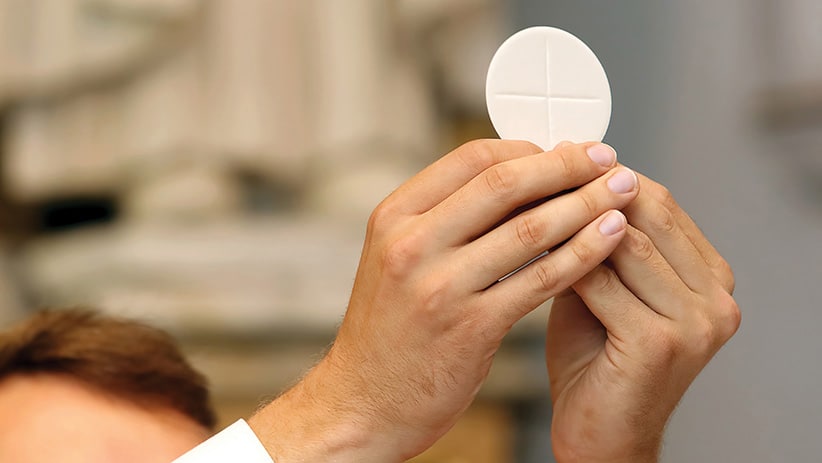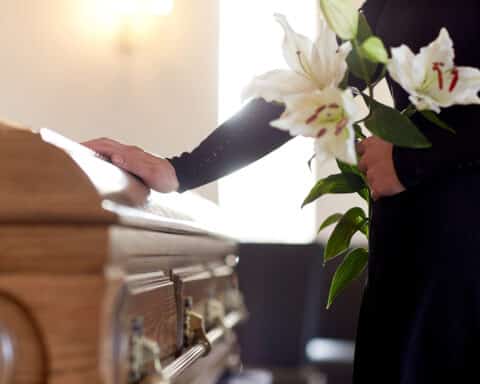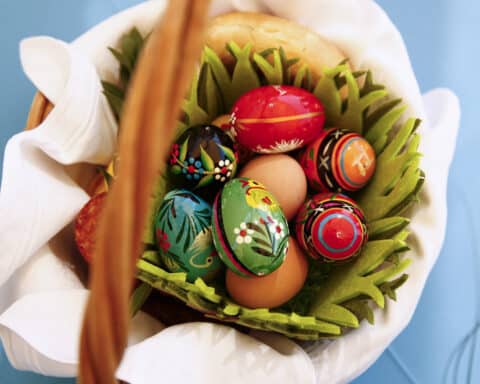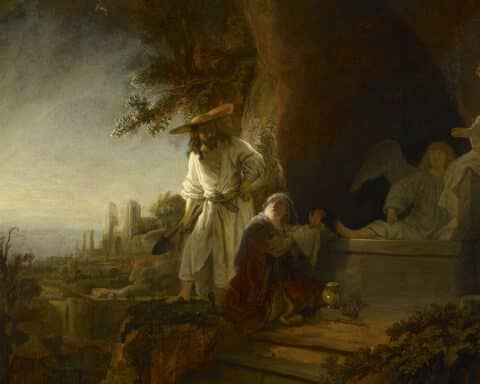You’re a brand new Catholic. Welcome! As you begin to get acclimated to the many traditions of the Catholic Faith, it is natural to be both joyful and perhaps even a little bit confused. There may be a thousand little details, customs and gestures that your Catholic friends take for granted that you simply are unfamiliar with. Worry not.
Included in this In Focus is a small sample of commonly asked questions about the Church and why and how we do what we do. These answers are just a beginning, and there is much more to learn and explore about the traditions of our beautiful faith.
As you learn, be patient with yourself. When in doubt, ask. Above all, remember that all these customs, gestures, rituals and prayers are intended to bring us closer to Christ. There’s no reason to be afraid, and there are many people you can talk to about them. And while these customs and rules are important, it’s good to remember that they are a means to a greater end. In the end, look to Christ, tell him what’s in your heart and do your best.
During Mass
What should I do when I first get into my pew?
Many Catholics will kneel and prayerfully prepare to join in the Eucharistic sacrifice. Clear your mind of any distractions and perhaps look over the readings in the worship aid.
Why do Catholics get down on one knee at certain times?
This is called a genuflection. Catholics genuflect toward the Lord’s Eucharistic presence in the tabernacle. Near the tabernacle is the sanctuary lamp — a candle often in a tall, red glass covering. This lamp is always lit when the Eucharist is in the church, reminding us that Christ sacramentally is present.
I see people doing several different kinds of bows and genuflections. When do I do what?
Catholics are asked to show reverence and adoration whenever passing in front of the tabernacle, where the Eucharist is reserved. This is typically done by genuflecting, although if unable, a profound bow from the waist is acceptable. Be purposeful. Touch your knee to the floor in reverence. Genuflect toward the tabernacle when you first enter the Church/your pew and when you leave. If it’s too hard physically, try to express reverence in some other way. When the Eucharist is exposed — that is, not inside the closed tabernacle — you should also genuflect. When you pass by the altar, if the tabernacle is not behind it, you should bow from the waist, because the altar represents Christ. Catholics bow from the waist during the Nicene Creed at the words “by the Holy Spirit was incarnate of the Virgin Mary, and became man,” in recognition that God humbled himself becoming like us in all things but sin. On the Annunciation and Christmas, Catholics celebrate that reality, and so are to genuflect at these words, rather than bowing. Bow your head whenever anyone says the holy names of Jesus or Mary, or the saint of the day.
People do something with their thumbs before the Gospel reading. What is it?
They are making a small cross with the right thumb on forehead, lips and heart. This is to express an interior prayerfulness that indicates that we’re ready to receive God’s word in our minds, spread it with our lips and hold it forever in our hearts.
I have a hard time following the worship aid (misselette). Can you help?
Each day’s readings are organized by date. You might need to follow along for the penitential rite and Gloria, or after the homily to follow along with the Nicene Creed and the Eucharistic prayers. As we are to be fully, actively and consciously participatory at Mass, we shouldn’t be too dependent on texts, but should work on memorizing the Mass parts.
What do I do at the sign of peace?
Recognize your brothers and sisters in Christ in the pews around you, and offer them Christ’s peace by saying “Peace be with you.” Make eye contact, shaking hands or offering a little wave. This is based in Scripture and is a gesture of unity with the congregation, saying “we’re all in the same boat together.”
I see people making many different gestures at Mass. What should I be doing?
While we may use any prayerful gestures in private prayer, it is important to remember that the gestures and postures the priest and laity make during the Mass have specific symbolic significance. You won’t be in trouble if you raise your arms at Mass, but it’s a good practice to do what the Church asks us to do. Do your best to follow the lead of the congregation.
My toddler made a break for the altar, and I gave chase without genuflecting. How much trouble am I in?
None. Try to strike a balance between being reverent and practical. Also be aware that most parishes have a “cry room” if needed.
COMMUNION
What do I do when I get to the head of the Communion line?
Catholics in the U.S. are asked to bow reverently from the waist, either when it’s your turn to receive or just before. When the minister of holy Communion says, “The body of Christ” or “The blood of Christ,” respond, “Amen.”
How do I actually receive Communion?
Catholics may receive Communion in the hand or directly on the tongue. The practice of receiving Communion on the hand is most ancient. If you receive Communion on the tongue, be sure that you stick your tongue out far enough for the minister of holy Communion to be able to firmly place it there. If you’re receiving in the hand, make a “cradle” or “throne” by cupping one hand under the other. Receive the Eucharistic bread in one hand and, picking it up reverently with the other, place it immediately into your mouth. When receiving the Precious Blood, take the chalice carefully with two hands, take a small sip, and return it to the minister of holy Communion.
Should I make the sign of the cross?
If you like. Many choose to do this out of reverence and recognition that they just received the holy bread of life and chalice of everlasting salvation.
What do I do when I get back to my pew?
Kneel down and pray in thanksgiving because you just received the greatest of gifts! There are several different “prayers after Communion” you can recite, or you can just speak to God whatever is in your heart.
When do I stop kneeling and sit down again?
While each diocese or country might have its own policy on the posture asked of the laity after Communion, the Vatican’s Congregation for Divine Worship and Discipline of the Sacraments recommended in 2003 that the faithful are free to kneel or sit if they so choose. Generally, go along with the congregation, or wait until the priest says, “Let us pray,” and then stand.
If I am unable to receive Communion, can I still go up and get a blessing?
Absolutely. Even though the priest will bless the entire congregation at the end of Mass, those unable to receive should feel free to join the rest of the faithful in the Communion line. Prior to walking up to the priest, cross your arms over your chest to signify that you aren’t going to receive Communion.
CONFESSION
I understand why we go to confession, but what do I do once I’m in the confessional?
Many Catholics can get nervous sometimes and forget what to say once inside the confessional. There are numerous “how-to” guides online. Priests also are used to walking people through the process, so if you don’t remember the steps, just ask him. Remember, the most important part of confession is that you’re forgiven of your sins. God’s grace and mercy are given freely.
| Act of Contrition |
|---|
|
In the confessional, after the priest proposes an act of penance, pray an act of contrition. A suggested act of contrition is:
My God,
I am sorry for my sins with all my heart.
In choosing to do wrong
and failing to do good,
I have sinned against you
whom I should love above all things.
I firmly intend, with your help,
to do penance,
to sin no more,
and to avoid whatever leads me to sin.
Our Savior Jesus Christ
suffered and died for us.
In his name, my God, have mercy. Source: USCCB
|
Do I have to go to confession at my own parish?
You can go to confession to any Catholic priest. Priests aren’t allowed to talk about what they heard in confession, and most don’t even remember. So there’s no need to avoid celebrating the sacrament with your parish priest for fear he will judge you in or outside the confessional.
How often should I go to confession?
While Church law requires Catholics “to confess faithfully his or her grave sins at least once a year,” more frequent reception of the sacrament is recommended.
Typically is it suggested to celebrate the sacrament monthly, although go any time you know you are in the state of mortal sin.
MISCELLANEOUS
Why are offering envelopes used in church?
Churches use envelopes for a variety of reasons. They make it easier to monitor charitable giving, such as if you need a tax statement for charitable donations. Also, some parishes give a discount on school tuition to regular donors, or they could be using them as a way to see who is or isn’t coming to Mass.
How do I arrange to have a Mass offered for someone?
Call the parish office. It’s customary to provide a stipend — an offering of money to the priest who offers the Mass. Dioceses usually have suggested stipends, but it’s important to know that you aren’t “buying” a Mass. If you can’t afford the stipend, worry not; you can’t be denied.
| Holy Days of Obligation |
|---|
|
Along with each Sunday, the faithful are obligated to attend Mass on the following days: – Jan. 1, the solemnity of Mary, Mother of God
– Thursday of the Sixth Week of Easter, the solemnity of the Ascension (for most dioceses, it’s transferred to the following Sunday)
– Aug. 15, the solemnity of the Assumption of the Blessed Virgin Mary
– Nov. 1, the solemnity of All Saints
– Dec. 8, the solemnity of the Immaculate Conception
– Dec. 25, the solemnity of the Nativity of Our Lord Jesus Christ
Whenever Jan. 1, Aug. 15 or Nov. 1 falls on a Saturday or on a Monday, the obligation to attend Mass is lifted.
Source: USCCB.org
|
What is a holy day of obligation?
Holy days of obligation are days when Catholics are required to go to Mass to celebrate events essential to our Faith. All Sundays are days of obligation. In the United States, there are six additional holy days of obligation. For some of these days, you may not be obligated to attend Mass if they fall on a Saturday or a Monday. If you’re unsure, check with your parish.
What does it mean when Catholics say the phrase “offer it up?”
For Christians, sacrifice is an essential element of Gospel living, emulating Jesus himself. Many people say they’re “offering up” a variety of things to God. It can be anything bad you have to endure (a headache, a missed plane, cancer) or anything good (a promotion, a sudden joy). Your sacrifice can be in praise to God, or for a specific reason (for the souls in purgatory; for my sister to find a job; because I’m sorry for my sins). God has given us everything, and knows its purpose, so it’s sensible to return it to him in thanksgiving, uniting it with the perfect offering of Jesus on the cross.
A friendly lady just told me she’ll pray for my intentions. What did she mean?
Primarily it means she will ask for God’s will to be done and for clarity of mind for those involved specifically in a given situation. It’s a way of praying for someone and knowing that God knows and understands the details. The pope announces his prayer intentions each month.
| What is a Novena? |
|---|
|
According to the Encyclopedia of Catholic Devotions and Practices (OSV, $39.95), the word novena “is derived from the Latin word novem, meaning ‘nine.'” A novena is any devotional practice performed over a period of nine days, emulating the nine days of intense prayer by the apostles after the Ascension as they awaited the coming of the Holy Spirit. Generally, the prayers are for a particular intention and call upon the intercession of Mary or a particular saint.
|
What does it mean to intercede on behalf of someone?
Intercession is to intervene with God on behalf of someone else. Typically, Catholics ask Mary, the saints and angels to intercede for us because of their closeness with God. When Catholics pray to saints, we are asking them to pray for us — to intercede with God — just like we might ask a friend to pray for a sick relative.
Do Catholics still skip meat on Fridays?
In the U.S., Catholics are obligated to refrain from eating meat on Fridays of Lent (fish and seafood are allowed). On Fridays outside of Lent, Catholics in the U.S. can substitute such abstinence with some other small penance or sacrifice, commemorating the day Jesus died. Catholics between 16 and 59 are required to fast — one full meal and two lesser meals — on Ash Wednesday and Good Friday.
SACRAMENTALS
| The Scoop on Sacramentals |
|---|
|
According to Sacrosanctum Concilium, Vatican II’s 1963 constitution on sacred liturgy, sacramentals are “sacred signs which bear a resemblance to the sacraments: they signify effects, particularly of a spiritual kind, which are obtained through the Church’s intercession. By them men are disposed to receive the chief effect of the sacraments, and various occasions in life are rendered holy.” Sacramentals include objects such as rosaries, holy water, crucifixes, candles, oils, scapulars and medals. They also can be actions or gestures, such as making the sign of the cross, praying the Stations of the Cross or devotions to saints.
|
How do I make the sign of the cross, and why is it important?
Typically, you would use the fingertips of your right hand to touch your forehead while saying “In the name of the Father,” then touch your chest while saying “… and of the Son …” then touch your left shoulder and then your right shoulder while saying “… and of the Holy Spirit.” (Eastern Christians do the reverse: right, then left.)
The Catechism of the Catholic Church recognizes the sign of the cross as one of the most important and basic prayers. It reads: “The Christian begins his prayers and activities with the sign of the cross” (No. 2166). In baptism, “the sign of the cross marks with the imprint of Christ the one who is going to belong to him and signifies the grace of the redemption Christ won for us by his cross” (No. 1235). And also, the sign of the cross “strengthens us in temptations and difficulties” (No. 2157) and “makes kings of all those reborn in Christ” (No. 786). A common practice is to make the sign of the cross while passing a Catholic church in reverence to the Blessed Sacrament within.
What are the uses of holy water?
The use of holy water primarily reminds us of our baptism and our new life in Christ. In using holy water, we ask for God’s blessing, forgiveness and protection. You may use holy water any time you go in or out of a church. Just dip your fingertips into the font and make the sign of the cross. Some people also have holy water fonts in their homes (they are sold at religious supply stores). To acquire holy water for home use, bring a bottle and help yourself from the receptacle that may be near the church entrance or the baptismal font. You can also ask a priest to bless water.
Now that I’m Catholic, does my house need a crucifix?
Yes! It’s not mandatory, but it helps us recall Jesus’ sacrifice, which is the center of our faith.
What do I do with the palms I received on Palm Sunday?
They are blessed, so treat them with respect. You may weave them into crosses and hang them in your home (look online for tutorials). If you want to dispose of them, it is preferable to bring them to your church for them to be burned. These ashes often are used on Ash Wednesday.
When should I light a votive candle?
Votive candles often are lit for a personal prayer intention. There’s no specific prayer you’re supposed to say — a memorized prayer or something spontaneous is fine. The candle keeps burning, signifying the continuation of our intention. You may place a monetary offering — typically to defray the cost of the candle — in the slot or box.
DEVOTIONS
I prayed the Rosary with a group, and I was unfamiliar with some of the prayers they said.
While the standard Rosary includes the Apostles’ Creed, the Our Father, the Hail Mary, the Glory Be, the Fatima Prayer and the Hail Holy Queen, some prayer groups include other prayers. If you aren’t familiar with them, don’t sweat it. Focus on the mysteries and the standard prayers. They can be found in any Catholic prayer book or on trusted online sites (OSV.com or USCCB.org).
| Mysteries of the Rosary |
|---|
|
Joyful Mysteries
(prayed on the Mondays, Saturdays, and Sundays of Advent)
– The Annunciation
– The Visitation
– The Nativity
– The Presentation in the Temple
– The Finding in the Temple Sorrowful Mysteries
(prayed on the Tuesdays, Fridays, and Sundays of Lent)
– The Agony in the Garden
– The Scourging at the Pillar
– The Crowning with Thorns
– The Carrying of the Cross
– The Crucifixion and Death Glorious Mysteries
(prayed on the Wednesday and Sundays outside of Lent and Advent)
– The Resurrection
– The Ascension
– The Descent of the Holy Spirit
– The Assumption
– The Coronation of Mary Luminous Mysteries
(prayed on Thursdays)
– The Baptism of Christ in the Jordan
– The Wedding Feast at Cana
– Jesus’ Proclamation of the Coming of the Kingdom of God
– The Transfiguration
– The Institution of the Eucharist
Source: USCCB.org
|
What do I do at Eucharistic adoration?
Eucharistic adoration is a wonderful time to grow closer to Christ. It’s appropriate to offer prayers of adoration, contrition, thanksgiving and supplication; read the Bible or any other spiritual reading, pray the Rosary, or just sit quietly and be with Jesus. At adoration, the Eucharist is exposed in a monstrance, often an elaborate vessel made of a precious metal. When entering or exiting the presence of the Lord in the Eucharist, express reverence by genuflecting.
What is Benediction all about?
Benediction is a practice in which Catholics adore and are blessed by the Eucharist. Typically there are opening and closing hymns, sometimes in Latin, and the priest and congregation recite prayers. Incense should be used as an expression of our worship in prayer. Benediction is an extra opportunity to focus on the Eucharist as the center of our lives. If you’re confused, just kneel along with the rest of the congregation and keep a respectful silence, while receiving God’s blessing. Generally, you can follow along with the liturgy for Benediction in the church’s worship aid.
Simcha Fisher is the author of “A Sinner’s Guide to Natural Family Planning” (OSV, $9.95). She blogs at Aleteia.org.





